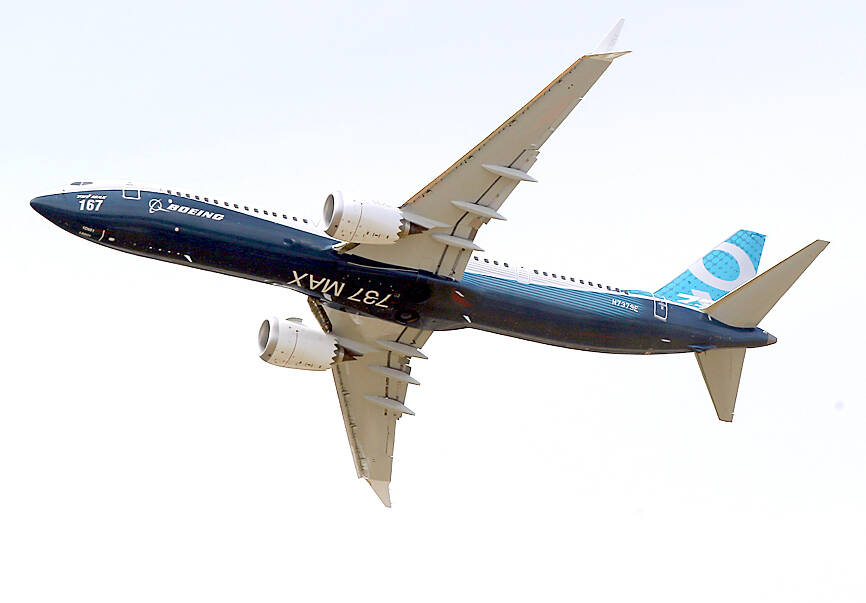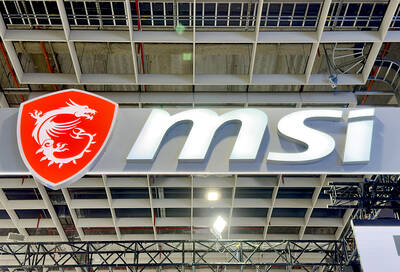Boeing Co losses widened for last year on weakness in its defense unit as it warned of further supply chain issues, but the US aircraft manufacturer reported its first yearly positive cash flow since 2018.
Boeing missed Wall Street expectations on revenue and earnings per share in the final quarter of the year. Shares have risen by more than 70 percent since September, but fell 1 percent on Wednesday.
Boeing CEO Dave Calhoun told analysts the company faces “a difficult, difficult supply chain, and while average deliveries met our objectives, we continue to face a few too many stoppages in our lines.”

Photo: AP
Those stoppages are lowering, but “not where they need to be,” Calhoun said.
Boeing chief financial officer Brian West said the company is increasing its abnormal accounting estimate by about US$600 million as it expects 787 production to remain lower for “a bit longer than expected due to a supplier constraint,” but still expects to raise its production rate to five aircraft per month later this year.
Boeing said that it plans this year to this year deliver up to 450 737 MAX narrow-body aircraft and 70 to 80 wide-body 787 Dreamliners.
The company said it expects to generate US$3 billion to US$5 billion in free cash flow this year.
Those numbers do not include the much-anticipated restart of Boeing jetliner deliveries to China. Calhoun declined to comment on when Chinese airlines might begin accepting aircraft from Boeing.
“Within China, they need the MAX to fly to satisfy those demands,” Calhoun said, adding that the potential opening of the Chinese market is a “serious bump” for the entire aviation industry.
Boeing previously expressed interest in remarketing a portion of the Chinese 737 MAX planes, but Calhoun on Wednesday said that Boeing would “pause” its efforts “so that we can discern what China wants to do.”
China Southern Airlines (中國南方航空) began flying the 737 MAX earlier this month after an almost four-year pause.
About 138 of the 200 737 MAX planes in storage are intended for Chinese customers.
The supply chain issues come as Boeing is trying to ramp up production.
Boeing last year was “showing some significant progress in key areas, although the reported financial results were mixed,” Third Bridge analyst Peter McNally said.
Boeing said net losses rose to US$5 billion for last year from US$4.3 billion in 2021, while losses from operations rose to US$3.5 billion last year from US$2.9 billion.
Boeing generated US$3.1 billion in free cash flow in the final quarter of last year. It had forecast about US$2.5 billion in free cash flow for the fourth quarter. Boeing reported US$2.3 billion for the full year.
Boeing reported fourth-quarter revenue of US$20 billion, up from US$14.79 billion last year, and a loss per share of US$1.75. Boeing had been expected to report US$20.38 billion in revenue in the quarter and a gain of US$0.26 a share, Refinitiv data showed.
While supply chain bottlenecks could hamper for the aerospace industry, McNally said jetliner demand remains strong, and Boeing has ramped up deliveries.
Boeing last month won approval from the US Congress to lift a deadline imposing a new safety standard for modern cockpit alerts for the MAX 7 and MAX 10.
The MAX 7 could have its first flights this year, and the MAX 10 “probably” next year, Calhoun said.

DIVIDED VIEWS: Although the Fed agreed on holding rates steady, some officials see no rate cuts for this year, while 10 policymakers foresee two or more cuts There are a lot of unknowns about the outlook for the economy and interest rates, but US Federal Reserve Chair Jerome Powell signaled at least one thing seems certain: Higher prices are coming. Fed policymakers voted unanimously to hold interest rates steady at a range of 4.25 percent to 4.50 percent for a fourth straight meeting on Wednesday, as they await clarity on whether tariffs would leave a one-time or more lasting mark on inflation. Powell said it is still unclear how much of the bill would fall on the shoulders of consumers, but he expects to learn more about tariffs

Meta Platforms Inc offered US$100 million bonuses to OpenAI employees in an unsuccessful bid to poach the ChatGPT maker’s talent and strengthen its own generative artificial intelligence (AI) teams, OpenAI CEO Sam Altman has said. Facebook’s parent company — a competitor of OpenAI — also offered “giant” annual salaries exceeding US$100 million to OpenAI staffers, Altman said in an interview on the Uncapped with Jack Altman podcast released on Tuesday. “It is crazy,” Sam Altman told his brother Jack in the interview. “I’m really happy that at least so far none of our best people have decided to take them

PLANS: MSI is also planning to upgrade its service center in the Netherlands Micro-Star International Co (MSI, 微星) yesterday said it plans to set up a server assembly line at its Poland service center this year at the earliest. The computer and peripherals manufacturer expects that the new server assembly line would shorten transportation times in shipments to European countries, a company spokesperson told the Taipei Times by telephone. MSI manufactures motherboards, graphics cards, notebook computers, servers, optical storage devices and communication devices. The company operates plants in Taiwan and China, and runs a global network of service centers. The company is also considering upgrading its service center in the Netherlands into a

NOT JUSTIFIED: The bank’s governor said there would only be a rate cut if inflation falls below 1.5% and economic conditions deteriorate, which have not been detected The central bank yesterday kept its key interest rates unchanged for a fifth consecutive quarter, aligning with market expectations, while slightly lowering its inflation outlook amid signs of cooling price pressures. The move came after the US Federal Reserve held rates steady overnight, despite pressure from US President Donald Trump to cut borrowing costs. Central bank board members unanimously voted to maintain the discount rate at 2 percent, the secured loan rate at 2.375 percent and the overnight lending rate at 4.25 percent. “We consider the policy decision appropriate, although it suggests tightening leaning after factoring in slackening inflation and stable GDP growth,”